The moment we’ve all been waiting for us here- it’s summertime! Kids are streaming out of their classrooms to the tune of school bells chiming for the last time and everybody is making their way to the nearest coastline.
But before you dive into the fun, be sure to ask yourself, “How’s my beach bod?” No, we’re not talking about weight loss or the perfect bikini. The only beach-bod you need to worry about is whether you’re doing your best to protect your skin from those sizzling sunrays. Today is always the perfect day to get a refresher on your risk of skin cancer and how to spot it as early as possible.
Read: Rates of pancreatic cancer are rising
What’s Your Risk of Skin Cancer?
Of course, sun exposure plays a major role in your risk level of skin cancer. Nonetheless, since skin cancer doesn’t exclusively develop on sun-exposed areas of your skin, it’s important to be aware of non-UV related causes as well.
Factors that raise your risk of skin cancer include: (1)
- Having fair skin. (Note: to date, people of color with skin cancer are typically diagnosed in a more advanced stage of the disease. It is essential to be informed about skin cancer and alert to changes in your skin, regardless of its shade!)
- Having skin that burns easily in the sun. If you have had one or more cases of blistering sunburns, your risk of skin cancer is elevated.
- Unprotected sun exposure. Spending excessive time in the sun without protection from clothing, shade, or sunscreen, as well as tanning (whether it’s outdoors or in a tanning salon) considerably raises your risk of skin cancer.
- Living in high-altitude or sunny climates.
- Having moles.
- Having precancerous skin lesions, known as actinic keratoses (more on this later!).
- Having a family history of skin cancer.
- Having a personal history of skin cancer.
- Having a compromised immune system. People living with a chronic illness that weakens the immune system, or people who take immunosuppressant drugs have a higher risk of developing skin cancer.
- Radiation exposure elevates your risk of skin cancer, especially basal cell carcinoma.
- Exposure to toxins, such as arsenic, raises your risk of skin cancer.
Monthly Self Examinations
Make a habit of inspecting your skin from scalp to sole once every month. It might help to associate this self check-up with a specific date like the first of the month or the day you pay your phone bill, for example.
The Skin Cancer Foundation advises, “You may find it helpful to have a doctor do a full-body exam first, to assure you that any existing spots, freckles, or moles are normal or treat any that may not be. After the first few times, self-examination should take no more than 10 minutes – a small investment in what could be a life-saving procedure.” (2)
The American Academy of Dermatology offers a free downloadable Body Mole Map which you can use to help keep track of your skin health. On your first full examination, make a note of each freckle, mole, bump, and rough patch on the Body Map. Where is it located? How big is it? What is its color? Every time you perform a full self-examination, check to see if anything has changed with existing spots and make a note of any new spots that appear.
Related: How to Do a Home Breast Cancer Exam
What Does Skin Cancer Look Like?
“The bottom line is if your skin starts forming a spot that doesn’t look like anything else and it’s not getting better, it’s growing, or it’s acting differently than your other moles, get it checked out,” says Saira J. George, MD, assistant professor of dermatology at The University of Texas MD Anderson Cancer Center. (3)
Basal Cell Carcinoma
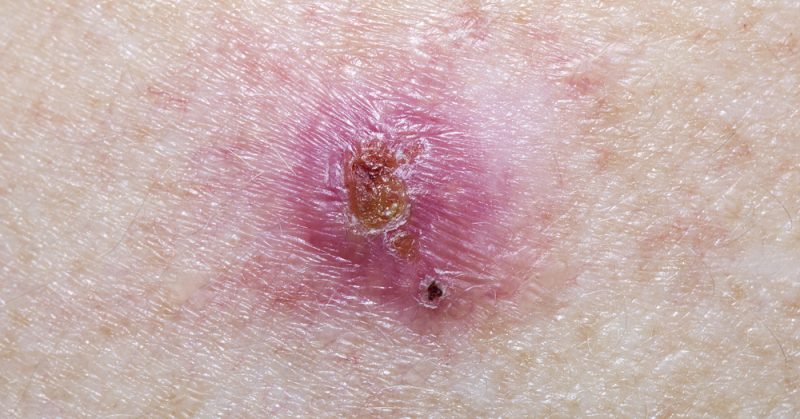
“Unfortunately, basal cell carcinoma is easy to ignore because a lot of times people think the spot is a pimple or blemish that won’t heal,” Dr. George says. Characteristics of basal cell carcinoma include: (3)
- Scar-like areas that appear flat, firm, and pale
- Shiny bumps or spots
- Reddish raised areas that can be itchy
- Open wounds that don’t seem to be fully healing
- Scabbed or oozing areas that bleed easily
- A growing bump or lesion
Squamous Cell Carcinoma
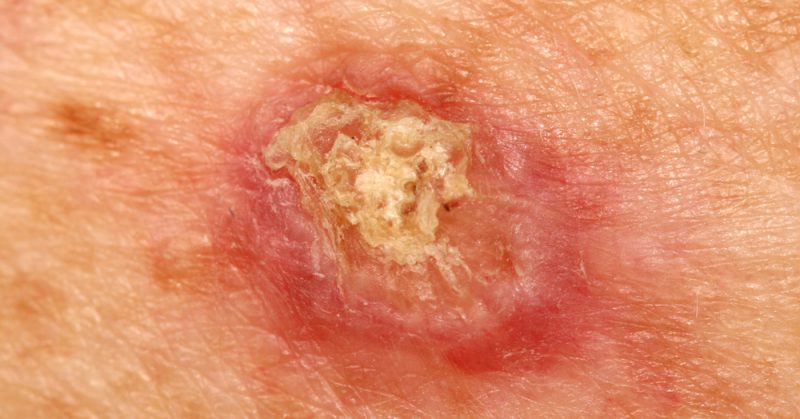
These skin cancers can also grow as a flat patch or become larger and nodular, advises Anthony Rossi, MD, board-certified dermatologist at Memorial Sloan Kettering Cancer Center. Their characteristics include: (3)
- Rough or scaly areas
- Raised bumps shaped somewhat like a donut
- Open wounds that don’t seem to be fully healing
- Wart-like growths
- Skin that is itchy, scabby, painful, or bleeds easily
Melanoma
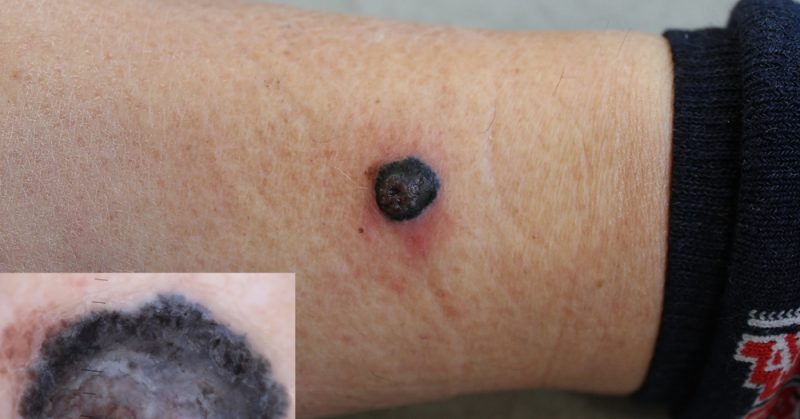
Refer to ABCDE to help recognize what could be signs of melanoma: (3)
- Asymmetry: Healthy, benign moles tend to be symmetrical. Do you have skin lesions that have an unusual shape?
- Border: Healthy, benign moles tend to have clearly defined borders. Do you have skin lesions with poorly defined or irregular edges?
- Color: Healthy, benign moles tend to be a single color (or perhaps two). Do you have skin lesions that are multi-colored, have color that is unevenly distributed, or has no color at all?
- Diameter: Do you have skin lesions larger than 6 mm across?
- Evolving: Healthy, benign moles tend to maintain their shape and size. Do you notice any differences between each skin exam? Has a mole become painful to the touch? Has it become larger, irregularly shaped, or changed in color?
If you spot any areas that fit the ABCDE check, ask your medical care provider to check it out. People of color are especially susceptible to a type of melanoma called acral lentiginous melanoma (ALM), which appears on the palms of the hands and the soles of the feet.
Actinic Keratosis
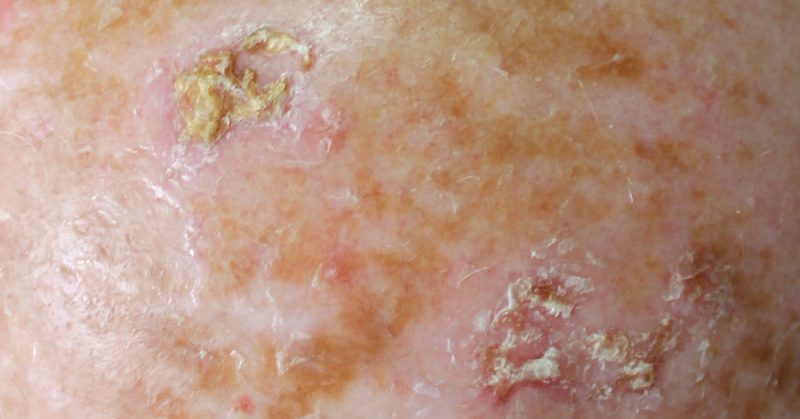
Actinic Keratosis lesions typically form on UV exposed areas of your skin such as the face, ears, and arms. Their characteristics include: (3)
- Dry, rough, or scaly areas
- Flat, raised areas
- Skin that is itchy or painful
- Skin lesions that vary in color, such as pink, red, and brown
Merkel Cell Carcinoma
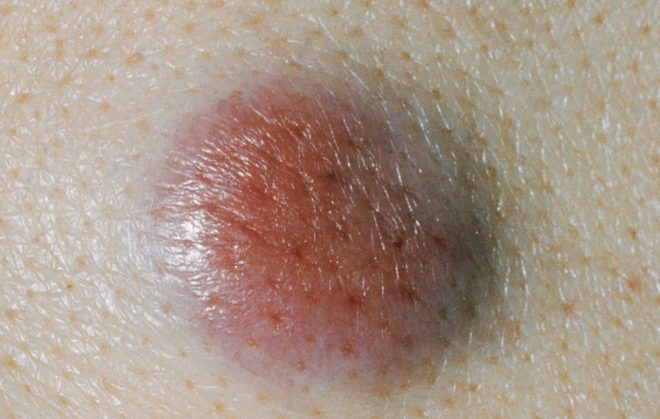
Merkel cell carcinoma characteristics include: (3)
- Discolored bump that may be shiny
- Firm bump that grows, but it painless
- Patches of broken skin that may bleed
Disclaimer: This information is not intended to be a substitute for professional medical advice, diagnosis or treatment and is for information only. Always seek the advice of your physician or another qualified health provider with any questions about your medical condition and/or current medication. Do not disregard professional medical advice or delay seeking advice or treatment because of something you have read here.
Read Next: 43-Year-Old Tennessee Woman Has Had 86 Skin Cancer Surgeries in the Past 20 Years
